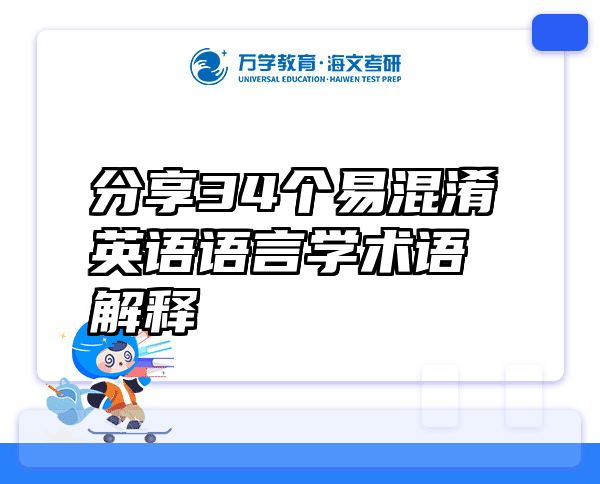分享34个易混淆英语语言学术语解释
2023-10-16 11:45:00
各位英语考研er,你的英语语言学复习得咋样了呀?英语语言学一向艰深晦涩,术语抽象,看起来非常像的术语,实际上含义大不相同,经常傻傻分不清楚/(ㄒoㄒ)/~~,要想搞清楚那些易混淆的语言学术语,还得靠英译英才能准确理解!文文为大家整理了34个易混淆英语语言学术语解释,赶快点击查看吧!
1、Phonological structure 音系结构

Which sound units are used and how they are put together
2、Phonological analysis 音系学分析
Take a word, replace one sound by another, and see whether a different meaning results.
(minimal pairs
3、Phonemic contrast
The relation between 2 phonemes when they occur in the same environment and distinguish meaning
4、Phonological rule 音系规则
a formal way of expressing a systematic phonologicalprocess or sound change in language.
5、Assimilation
Dissimilation 异化
A process where 2 identical or similar phonemes changes or displaces the other one
6、Suprasegmental/Phonological features (syllable stress tone intonation
Those aspects of speech that involve more than single sound segments
7、Syllable structure 音节结构 (divided into rhyme and onset
8、Componential analysis
A way in which the meaning of a word can be dissected into meaning components, called semantic features.
9、Grammatical construction 语法结构
The process of internal organization of a grammatical unit
( IC analysis
10、Syntactic construction 句法结构
(endo/exo-centric construction
11、Syntactic function 句法功能
Shows the relationship between a linguistic form and other parts of the linguistic pattern in which it is used
12、Grammatical rule
By which the grammaticality of a sentence is governed
13、Grammatical relations
The structural and logical functional relations of constituents
14、Syntactic relations
positional/substitutability/co-occurrence
15、syntagmatic relation
between one item and others in a sequence, or between elements which are all present.
16、paradigmatic relation
a relation holding between elements replaceable with each other at a particular place in a structure, or between one element present and he others absent.
17、immediate constituent analysis:
the analysis of a sentence in terms of its immediate constituents
18、Distinctive features:
a term of phonology, i.e. a property which distinguishes one phoneme from another.
(phonological contrast binary/place features
19、Allophone: any of the different forms of a phoneme
allomorph: any of the different form of a morpheme.
20、Phoneme: smallest constrastive unit in the sound system of a language
21、Morpheme: smallest meaningful linguistic unit
22、Phonetics:how speech sounds are made, transmitted and received (description&classification
23、Phonology: sound pattern& shape of syllables
24、Morphology: internal organization of words--minimal meaning unit+word formation processes
25、Syntax: interrelationships between elements in sentence structure
(principles of forming&understanding correct English sentences
26、Semantics: the meaning of linguistic units (how meaning is encoded in a language
27、Pragmatics: use of language in a context (meaning in context
28、Inflectional morphemes manifest various grammatical relations
29、Derivational affixes are added to an existing form to create a new word
30、Constative: statements that either state or describe, and were verifiable.
31、Performative: sentences that did not state a fact or describe a state, and were not verifiable.Their function is to perform a particular speech act.
In what way can we determine whether a phone is a phoneme or not?
A basic way to determine the phonemes of a language is to see if substituting one sound for another results in a change of meaning. If it does, the two sounds then represent different phonemes.
Language is both linearly and hierarchically structured.
The tree diagram can not only reveal a linear order, but also a hierarchical structure that groups words into structural constituents. + to most truthfully illustrate the constituent relationship among linguistic elements.
there are two aspects to sentence meaning: grammatical meaning and semantic meaning.
32、Componential analysis
proposed by structural semanticists, is a way to analyze word meaning. The approach is based on the belief that the meaning of a word can be divided into meaning components, which are called semantic features. Plus and minus signs are used to indicate whether a certain semantic feature is present or absent in the meaning of a word, and these feature symbols are usually written in capitalized letters. For example, the word “man” is analyzed as consisting of the semantic features of [+ HUMAN, + ADULT, + ANIMATE, +MALE]
A sentence is a grammatical concept. It usually consists of a subject and predicate.
An utterance is the unit of communication. It is the smallest linguistic unit that has a
communicative value. If we regard a sentence as what people actually utter in the course of communication, it becomes an utterance.
A sentence meaning is often considered as the intrinsic property of the sentence itself in terms of a predication. It is abstract and independent of context.
The utterance meaning is based on sentence meaning; it is realization of the abstract meaning of a sentence in a context. The meaning of an utterance is concrete, and context-dependent.
For example...
33、Argument:some entity about which a statement is being made
34、Predicate: some property or relation to the entity
以上就是问文文为大家整理的34个易混淆英语语言学术语解释啦,现在你能分清楚了吗?想要电子版信息的同学DD文文哦~
(内容来源于网络,由成都海文考研收集整理,具体情况以学校官网为准,侵权必删!)
上一篇: 英美文学考研简答题论述题赏析题怎么答?
下一篇: 法硕必背!最全最新超级背诵清单来了


